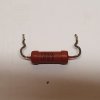jifcom
New Member
Hi all,
new here but unfortunately old elsewhere.
I have a quick question about a Resistor value?
to put in context I will explain, I am into vintage HiFi, all Yamaha gear from the 70s.
I just picked up a almost mint 1977 Yamaha CA-2010 Amp. for my collection, everything all working lovely bit no lamps working?
I have had to change quite a few bulbs before in my collection, not hard but gets a bit weary as it seems they blow quite regularly. I had though about LEDs but when looked into it, found it quiet daunting!!
so anyway, took the top off and removed the lamp board but a closer look did not see the tell tale burn on the lamps so carefully plugged back in and turned on, then tested the voltage across the power feeds to the board, Nothing!
so then turned off and unplugged and turned over the Amp to remove the bottom plate to access the fuses, but before I could test them I noticed a rather blackened resistor!
and the fused had blown as well.
Unable to see what the value was of the resistor was, I referred to the wiring diagrams for the Amp, found out its a 10 ohm resistor but thats all I know, so no idea what wattage?
I have attached a screenshot of the diagram and the resistor highlighted in Yellow.
Can anyone identify the resistor? in context to the diagram, take into account that its more than 40yrs old, what would be the modern equivalent?
before anyone ask's, the photo of the resistor is not the one blown, I took it out of another identical Amp.
Any help would be appreciated by this Oldie, who need to play music loud to be able to hear it (or thats what I tell the wife )
)
Regards
Jon
new here but unfortunately old elsewhere.
I have a quick question about a Resistor value?
to put in context I will explain, I am into vintage HiFi, all Yamaha gear from the 70s.
I just picked up a almost mint 1977 Yamaha CA-2010 Amp. for my collection, everything all working lovely bit no lamps working?
I have had to change quite a few bulbs before in my collection, not hard but gets a bit weary as it seems they blow quite regularly. I had though about LEDs but when looked into it, found it quiet daunting!!
so anyway, took the top off and removed the lamp board but a closer look did not see the tell tale burn on the lamps so carefully plugged back in and turned on, then tested the voltage across the power feeds to the board, Nothing!
so then turned off and unplugged and turned over the Amp to remove the bottom plate to access the fuses, but before I could test them I noticed a rather blackened resistor!
and the fused had blown as well.
Unable to see what the value was of the resistor was, I referred to the wiring diagrams for the Amp, found out its a 10 ohm resistor but thats all I know, so no idea what wattage?
I have attached a screenshot of the diagram and the resistor highlighted in Yellow.
Can anyone identify the resistor? in context to the diagram, take into account that its more than 40yrs old, what would be the modern equivalent?
before anyone ask's, the photo of the resistor is not the one blown, I took it out of another identical Amp.
Any help would be appreciated by this Oldie, who need to play music loud to be able to hear it (or thats what I tell the wife
Regards
Jon


